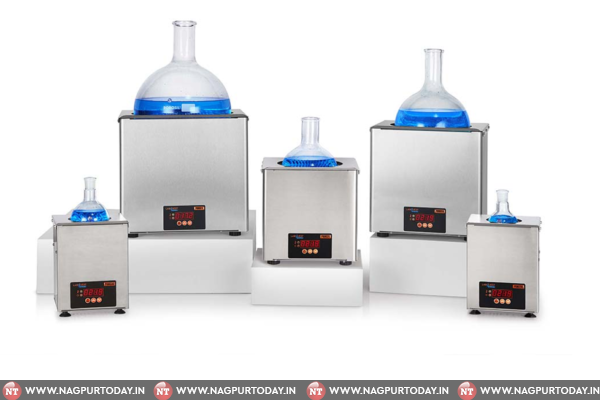
When it comes to precision heating in a laboratory, heating mantles are not only reliable but also energy-efficient. Laboratories rely on various energy-consuming devices, making sustainability a key factor in reducing environmental impact and operational costs. Compared to hot plates, oil baths, or Bunsen burners, heating mantles offer a safer and more efficient solution for distillation, evaporation, and extraction experiments.
In this post, we’ll explore key factors to consider when selecting heating mantles, how they enhance both efficiency and safety and why they are an essential part of your lab essentials.
What Are Heating Mantles and Why Are They Important?
Heating mantles are designed for evenly distributing heat around containers like flasks without the risk of hot spots or direct flame contact. Unlike other heating devices, mantles provide even heating across the surface of flasks and other glassware, preventing the risk of glass breakage.
Key Components of Heating Mantles:
- Fabric or Metal Housings: Offers insulation and contains the heating element.
- Heating Element: A coiled wire is typically embedded within a fibrous insulating material.
- Control Units: Manage the temperature and maintain safety standards.
Identifying Your Laboratory Needs
Before choosing a heating mantle, consider what your laboratory needs. Factors to include are the type of solutions you’ll be heating, the volume of substances, and the specific temperature requirements for your experiments.
Common Laboratory Requirements:
- Volume Handling: From small beakers to large flasks, ensure the mantle can accommodate the glassware used.
- Temperature Precision: For sensitive chemical reactions, precise temperature control is crucial.
- Safety Features: Look for mantles with spill detection, safety cutoffs, and durable materials to enhance lab safety.
Key Factors to Consider When Choosing a Heating Mantle
Once you understand your lab’s requirements, it’s important to compare different heating methods to select the most suitable option. Laboratories rely on various heating methods for distillation, evaporation, and extraction. However, factors like energy efficiency, safety, and temperature control vary significantly across different options:
- Bunsen Burners/Open Flame – A traditional method but inefficient, posing fire hazards and offering no temperature control.
- Hot Plates – Suitable for flat-bottom flasks but have moderate efficiency and temperature variability.
- Oil Baths – Provide uniform heating but require monitoring due to spill risks and slower temperature response.
- Temperature-Controlled Heating Mantles – The most energy-efficient and safest option, ideal for round-bottom flasks with precise temperature control and minimal heat loss.
Among temperature-controlled heating mantles, different types cater to specific lab needs:
- Multiposition Heating Mantles – Allow multiple experiments to run simultaneously at different temperatures, improving efficiency in high-activity labs.
- Temperature-Controlled Heating Mantles – Equipped with advanced PID or analog controls for precise temperature regulation, making them essential for distillation and reflux processes.
- Stirring and Heating Mantles – Combine uniform heating with controlled stirring, ideal for solution preparation, titrations, and reactions requiring continuous agitation.
For a comparative analysis of these heating methods, refer to the chart below.
Comparison of Heating Methods for Lab Use
| Heating Method | Energy Efficiency | Safety | Temperature Control | Heat Loss | Best For |
| Temperature-Controlled Heating Mantles | High | Very Safe | Precise (PID/Analog) | Minimal | Round-bottom flasks, precise heating |
| Oil Baths | Low | Spill Risk | Slow Response | High | Even heating but requires monitoring |
| Hot Plates | Moderate | Hot Surface Risk | Variable | Moderate | Flat-bottom flasks, general heating |
| Bunsen Burner/Open Flame | Very Low | Fire Hazard | No Control | Extreme | Not recommended due to safety risks |
Here are two common types of burners used primarily in labs:
| Feature | Energy Rheostat Heating Mantles | CE Certified Temperature-Controlled Heating Mantles |
| Energy Efficiency | Manual power adjustment, higher energy consumption | Automatic energy optimisation with PID controller |
| Temperature Control | User-dependent lacks feedback, fluctuates | Digital PID control ensures stable temperatures |
| Safety Features | No auto cut-off, risk of overheating | Overheat protection, spill prevention, safe shutdown |
| User Convenience | Requires manual monitoring | Automated temperature control, programmable settings |
| Compliance & Certification | No CE certification, may not meet safety norms | CE Certified meets GMP/GLP standards |
| Durability & Lifespan | Higher wear due to voltage fluctuations | Longer lifespan with controlled heating cycles |
For optimal lab safety and efficiency, Temperature-controlled heating mantles offer precise temperature regulation, energy savings, and enhanced durability, making them a better choice than manual rheostat-based models. Leading brands like Borosil Scientific design these mantles with advanced PID controllers, overheat protection, and automated settings, ensuring consistent performance, compliance with industry standards, and long-term reliability for various laboratory applications.
Conclusion
In conclusion, choosing the right heating mantle is essential for laboratory efficiency, safety, and energy management. Temperature-controlled heating mantles, particularly those with advanced PID control and CE certification, offer the most precise and energy-efficient heating for various lab applications. With features like overheat protection and automatic energy optimization, these models enhance operational safety while reducing environmental impact.
When selecting a heating mantle, it is crucial to prioritise precise temperature control and durability, ensuring that your lab equipment supports both your scientific work and sustainability goals—traits well exemplified by high-quality, CE-certified temperature-controlled models available today.













